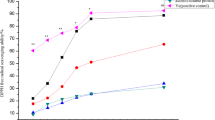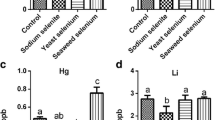Abstract
Since selenium and vitamin E have been increasingly recognized as an essential element in biology and medicine, current research activities in the field of human medicine and nutrition are devoted to the possibilities of using these antioxidants for the prevention or treatment of many diseases. The present study was aimed at investigating and comparing the effects of dietary antioxidants on glutathione reductase and glutathione peroxidase activities as well as free and protein-bound sulfhydryl contents of rat liver and brain tissues. For 12–14 wk, both sex of weanling rats were fed a standardized selenium-deficient and vitamin E-deficient diet, a selenium-excess diet, or a control diet. It is observed that glutathione reductase and glutathione peroxidase activities of both tissues of the rats fed with a selenium-deficient or excess diet were significantly lower than the values of the control group. It is also shown that free and bound sulfhydryl concentrations of these tissues of both experimental groups were significantly lower than the control group. The percentage of glutathione reductase and glutathione peroxidase activities of the deficient group with respect to the control were 50% and 47% in liver and 66% and 61% in the brain, respectively; while these values in excess group were 51% and 69% in liver and 55% and 80% in brain, respectively. Free sulfhydryl contents of the tissues in both experimental groups showed a parallel decrease. Furthermore, the decrease in protein-bound sulfhydryl values of brain tissues were more pronounced than the values found for liver. It seems that not only liver but also the brain is an important target organ to the alteration in antioxidant system through either a deficiency of both selenium and vitamin E or an excess of selenium alone in the diet.
Similar content being viewed by others
References
I. Y. Kim and T. C. Stadtman, Inhibition of NF-kB DNA binding and nitric oxide induction in human T cells and lung adenocarcinoma cells by selenite treatment, Proc. Natl. Acad. Sci. USA 94, 12,904–12,907 (1997).
S. W. May, L. Wang, M. M. Gill-Woznichak, et al., An orally active selenium-based antihypertensive agent with restricted CNS permeability, J. Pharmacol. Exp. Ther. 283(2), 470–477 (1997).
J. A. Award, R. F. Burk, and L. J. Roberts II, Effect of selenium deficiency and glutathione-modulating agents on diquat toxicity and lipid peroxidation in rats, J. Pharmacol. Exp. Ther. 270(3), 858–864 (1994).
D. Behne, C. Weiss-Nowak, M. Kalcklosch, et al., Studies on the distribution and characteristics of new mammalian selenium-containing proteins, Analyst 120, 823–825 (1995).
J. E. Spallholz, On the nature of selenium toxicity and carcinostatic activity. Free Radical Biol. Med. 17, 45–64 (1994).
T. C. Stadtman, Biosynthesis and function of selenocysteine-containing enzymes, J. Biol. Chem. 266(25), 16,257–16,260 (1991).
B. Turan, O. Hotomaroglu, M. Kilic, and E. Demirel-Yilmaz, Cardiac dysfunction induced by low and high diet antioxidant levels comparing selenium and vitamin E in rats, Regulat. Tox. Pharmacol. 29, 142–150 (1999).
B. Turan, N. Zaloglu, E. Koc, Y. Saran, and N. Akkas, Dietary selenium and vitamin E induced alterations in some rabbit tissues, Biol. Trace Element Res. 58(3–4), 237–253 (1997).
R. J. Shamberger, Selenium deficiency diseases in animals, in Biochemistry of Selenium, Plenum, New York, pp. 31–58, (1983).
A. S. Prasad, Clinical biochemical and nutritional aspects of trace elements, Curr. Topics Nutr. Dis. 6, 345–349 (1982).
B. Venugopal and T. Luckey, Metal toxicity in mammals, in Toxicity of Group VI Metals and Metalloids, Plenum, New York, pp. 234–400, (1978).
X. Chen, G. Yang, J. Chen, X. Chen, Z. Wen, and K. Ge, Studies on the relationships of selenium and Keshan disease, Biol Trace Element Res. 2, 91–107 (1980).
J. Ringstad, P. M. Tande, G. Norheim, and H. Refsum, Selenium deficiency and cardiac electrophysiological and mechanical function in the rat, Pharmacol. Toxicol. 63, 189–192 (1988).
J. A. Olson and S. Kobayoshi, Antioxidants in health and disease: overview, Proc. Soc. Exp. Biol. Med. 200, 245–247 (1992).
J. D. Young, C. Crowley, and E. M. Tucker, Haemolysis of normal and glutathione-deficient sheep erythrocytes by selenite and tellurite, Biochem. Pharmacol. 30, 2527–2530 (1981).
I. Anundi, J. Hogberg, and A. Stahl, Involvement of glutathione reductase in selenite metabolism and toxicity, studied in isolated rat hepatocytes, Arch. Toxicol. 50, 113–123 (1982).
S. Y. Lin-Shiau, S. H. Liu, and W. M. Fu, Studies on the contracture of the mouse diaphragm induced by sodium selenite, Eur. J. Pharmacol. 167, 137–146 (1989).
R. C. Dickson and A. L. Tappel, Reduction of selenocystine by cysteine or glutathione, Arch. Biochem. Biophys. 130, 547–550 (1969).
J. Hakkarainen, P. Lindberg, G. Bengtsson, L. Jonsson, and N. Lannek, Requirement for selenium (as selenite) and vitamin E (as a-tocopherol) in weaned pigs. III. The effect on the development of the VESD syndrome of varying selenium levels in a low-tocopherol diet, J. Anal. Sci. 46, 1001–1008 (1978).
J. R. Beetens, M. C. Coene, A. Veheyen, L. Zonnekeyn, and A. G. Herman, Vitamin C increases the prostacyclin production and decreases the vascular lesions in experimental atherosclerosis in rabbits, Prostaglandins 32, 335–352 (1986).
E. Hayashi, J. Yamada, M. Kunitomo, M. Terada, and M. Sato, Fundemental studies on physiological and pharmacological actions of l-ascorbate 2-sulfate. V: On the hypolipidemic and antiatherosclerotic effects of l-ascorbate 2-sulfate in rabbits, Jpn. J. Pharmacol. 28, 61–72 (1978).
J. Wojcicki, L. Rozewicka, B. Barcew-Wiszniewska, et al., Effect of selenium and vitamin E on the development of experimental atherosclerosis in rabbits, Atherosclerosis 87, 9–16 (1991).
M. M. Mahfouz, H. Kawano, and F. A. Kummerow, Effect of cholesterol-rich diets with and without added vitamins E and C on the severity of atherosclerosis in rabbits, Am. J. Clin. Nutr. 66, 1240–1249 (1997).
N. L. Acan and E. F. Tezcan, Sheep brain glutathione reductase: purification and general properties, FEBS Lett. 250, 72–74 (1989).
R. A. Lawrence and R. F. Burk, Glutathione peroxidase activity in selenium-deficient rat liver, Biochem. Biophys. Res. 71, 952–958 (1976).
J. Sedlak and R. H. Lindsay, Estimation of total, protein-bound, and nonprotein sulfhydryl groups in tissue with Ellman’s reagent, Anal. Biochem. 25, 192–205 (1968).
M. M. Bradford, A rapid and sensitive method for the quantitation of microgram quantities of protein in tissue with Ellman’s reagent, Anal. Biochem. 72, 248–254 (1976).
H. E. Ganther, Pathways of selenium metabolism including respiratory excretory products, J. Am. Coll. Toxicol. 5, 1–5 (1986).
J. T. Sword, A. I. Pope, and W. G. Hoekstra, Endotoxin and lipid peroxidation in vitro in selenium- and vitamin E-deficient and -adequate rat tissues, J. Nutr. 121, 258–264 (1991).
J. T. Sword, A. I. Pope, and W. G. Hoekstra, Endotoxin and lipid peroxidation in vivo in selenium- and vitaminE-deficient and -adequate rats, J. Nutr. 121, 251–257 (1991).
D. D. Maag and M. W. Glenn, Toxicity of selenium: farm animals, in Selenium in Biomedicine: A Symposium, O. H. Muth, J. E. Oldfield, and P. H. Weswig, eds., AVI, Westport, CT, pp. 109–123, (1967).
S. A. Hopper, A. Greig, and C. H. McMurray, Selenium poisoining in lambs, Vet. Rec. 116, 569–571 (1985).
J. B. A. Smyth, J. H. Wang, R. M. Barlow, D. J. Humphreys, M. Robins, and J. B. J. Stodulski, Experimental acute selenium intoxication in lambs, J. Compar. Pathol. 102, 197–209 (1990).
G. Danscher, Exogenous selenium in the brain, Histochemistry 76, 281–293 (1982).
N. N. Ulusu, N. L. Acan, B. Turan, and E. F. Tezcan, The effect of selenium on glutathione redox cycle enzymes of some rabbit tissues, Trace Element Electrolytes 17(1), 25–29 (2000).
L. D. Koller and J. H. Exon, The two faces of selenium-deficiency and toxicity—are similar in animal and man, Can. J. Vet. Res. 50, 297–306 (1986).
O. A. Levander, Selenium, in Trace Elements in Human and Animal Nutrition, W. Mertz, ed., Academic, New York, pp. 209–279, (1986).
K. Ytrehus, J. Ringstad, R. Myklebust, G. Norheim, and O. D. Mjos, The selenium-deficient rar heart with special reference to tolerance against enzymatically generated oxygen radicals, Scand. J. Clin. Lab. Invest. 48, 289–295 (1988).
K. H. Konz, M. Haap, K. K. Hill, R. F. Burk, and R. A. Walsh, Diastolic dysfunction of perfused rat hearts induced by hydrogen peroxide. Protective effect of selenium, J. Mol. Cell. Cardiol. 21, 789–795 (1989).
Author information
Authors and Affiliations
Rights and permissions
About this article
Cite this article
Turan, B., Acan, N.L., Ulusu, N.N. et al. A comparative study on effect of dietary selenium and vitamin E on some antioxidant enzyme activities of liver and brain tissues. Biol Trace Elem Res 81, 141–152 (2001). https://doi.org/10.1385/BTER:81:2:141
Received:
Revised:
Accepted:
Issue Date:
DOI: https://doi.org/10.1385/BTER:81:2:141




